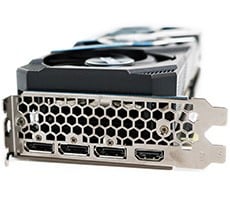HIS X1650 Pro IceQ Turbo Dual DL-DVI
|
|
|
|
Motherboard - Video Cards - Memory - Audio - Hard Drive -
|
Hardware Used: AMD Athlon 64 X2 4600+ (2.4GHz x 2) Asus M2R32-MVP ATI Radeon Xpress 3200 HIS Radeon X1650 Pro IceQ Turbo (625/700 - Rated, 621/688.5 - Actual) Sapphire Radeon X1600 Pro (500/810) GeForce 7600 GT (580/700) 2048MB PQI PC24200 Turbo CAS 3 Integrated on board IBM Deskstar 82GB - 7,200RPM - IDE |
Operating System - Chipset Drivers - DirectX - Video Drivers - Synthetic (DX) - DirectX - DirectX - OpenGL - OpenGL - |
Relevant Software: Windows XP Professional SP2 Catalyst 6.10 DirectX 9.0c (August Redist.) NVIDIA Forceware v91.47 ATI Catalyst v6.10 Benchmarks Used: 3DMark06 v1.0.2 F.E.A.R. v1.07 Half Life 2: Lost Coast Prey* Quake 4 v1.2* * - Custom Test (HH Exclusive demo) |
|
|
|
| 3DMark06 is the latest addition to the 3DMark franchise. This version differs from 3Dmark05 in a number of ways, and now includes not only Shader Model 2.0 tests, but Shader Model 3.0 and HDR tests as well. Some of the assets from 3DMark05 have been re-used, but the scenes are now rendered with much more geometric detail and the shader complexity is vastly increased as well. Max shader length in 3DMark05 was 96 instructions, while 3DMark06 ups the number of instructions to 512. 3DMark06 also employs much more lighting, and there is extensive use of soft shadows. With 3DMark06, Futuremark has also updated how the final score is tabulated. In this latest version of the benchmark, SM 2.0 and HDR / SM3.0 tests are weighted and the CPU score is factored into the final tally as well. |

With its 121MHz and roughly 290MHz faster GPU and memory, the X1650 Pro holds a significant advantage over the X1600 Pro. The overall clock speed increase resulted in an increase of 35% in the default 3DMark06 test. THe Shader Model 2.0 test went up close to 40% and Shader Model 3.0/HDR 36%. Regardless, the GeForce 7600 GT outperformed both cards by a significant margin in all tests.







